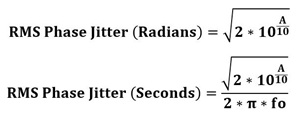The phase noise to phase jitter converter allows you to transform an integrated phase noise value (expressed in dBc) into RMS jitter of the signal. The result is given both in radians (angular deviation) and in microseconds (time deviation). This tool helps engineers evaluate the temporal stability of an oscillator or clock, and understand how phase noise affects signal accuracy.
Formula
j rad = √(2 × 10^(A / 10))
j µs = j rad / (2π × f o ) × 10 6

Explanation of the formula
The first equation calculates the RMS jitter in radians from the integrated phase noise A (dBc). We first convert A to a linear value using 10^(A/10), then multiply by 2 and take the square root of it to obtain the average angular deviation.
The second equation translates this angular deviation into temporal deviation. It divides the previous value by the heart rate (2πf₀) and multiplies the result by 10 6 to express the jitter in microseconds. This allows the temporal error caused by phase noise to be directly quantified.
Uses
- Analyze the temporal quality of an oscillator, a frequency synthesizer or a digital clock.
- Evaluate the influence of phase noise on the overall performance of an RF or communications system.
- Optimize the design of filters and PLL loops to reduce jitter in synchronized systems.
- Present accurate results in reports and technical documents by converting phase noise into measurable temporal metrics.